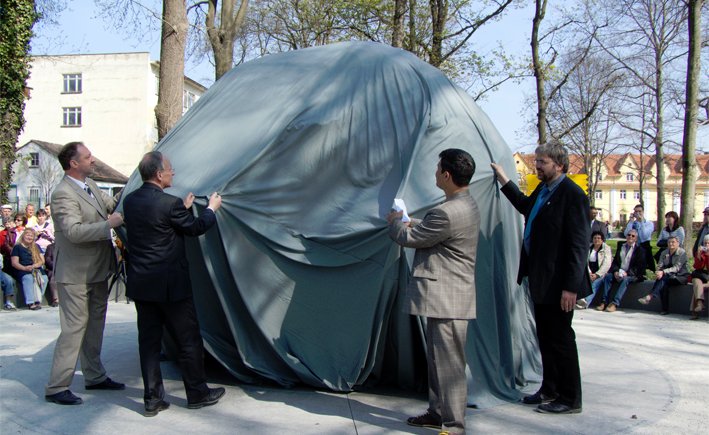Arts and Geoscience
24.04.2010 | Potsdam: With the inauguration of a three meter high bronze globe, the main work of art for the regional garden show in Saxon-Anhalt was today introduced to the public. The basis of the work created by the Berlin artist, Oliver Störmer, was the shape of the Earth calculated by scientists at the GFZ German Research Centre for Geosciences, the “Potsdam Geoid”. Due to its precise portrayal of the uneven gravity field of the Earth, this geoid is also known worldwide as the “Potsdam Potato”.
The idea for the work of art is based on a revolutionary shaped globe from the 17. Century, developed by the “big” son of the city of Aschersleben, Adam Olearius (1599 – 1671). As the court mathematician of Herzog Friedrich III. of Schleswig-Holstein-Gottorf, he became known far beyond the borders in 1654, when he created the so-called Gottorf giant globe with a diameter of three meters. Its exterior was covered with the continents and world oceans, corresponding to the state of knowledge at that time. The inside, on the other hand, represented a small planetarium, however still strictly geocentrically according to Ptolemaeus. Later efforts were made to integrate the planets and herewith the new conception of the world according to Kepler into the internal wheelwork of the planetarium; however, all efforts failed due to the complicated mechanics, necessary for such an undertaking. The Gottorf Globe, at that time world-famous, thus stands exactly at the interface between the religiously dominated science before, and the worldly determined science after the 17. Century.
This thought fascinated the Berlin artist, Olive Störmer. He designed the “Aschersleber Globe” for the birth place of Olearius, a likewise three meters high bronze sculpture, based on the Potsdam Potato, i.e. based on the geoid portrayal of the Earth, as calculated by Potsdam geoscientists. “The modern picture of the Earth as a high-precision measured geoid returns as a work of art”, explained the GFZ geoscientist, Christoph Förste, who represented the Chairman of the Board of the GFZ German Research Centre for Geosciences, Prof. Dr. Reinhard Huettl, who was unable to attend the inauguration of the work of art. “And, as Olearius portrayed the modern conception of the world in the 17. Century, Oliver Störmer does likewise with the Potsdam Geoid for the 21. Century, and we as the GFZ German Research Centre for Geosciences are naturally proud of to be part of this tradition, both scientifically and artistically.”
The scientific and artistic aesthetics blend together in the Aschersleber Globe, in which the portrayal of the Earth, developed from satellite data, flows digitally into the handcraft of the artist.
www.aschersleber-globus.de (in German)
and








![[Translate to English:] Torsten Sachs in front of a climate station on a field](/fileadmin/_processed_/3/9/csm__TorstenSachs_bearbeitet_GS_4a1365ef84.jpeg)

![[Translate to English:] left image flood at the Ahrtal: image from above, several houses are flooded; left image:: Heidi Kreibich;](/fileadmin/_processed_/4/4/csm_Bild2_9af0130e9f.png)



![[Translate to English:] Start der Vega Rakete](/fileadmin/_processed_/6/4/csm_20231201-kachel_Vega-VV23-launch_ESA-CNES-Arianespace_706716b68c.jpeg)









![[Translate to English:] Poster exhibition at the Brandenburg Hydrogen Day at the GFZ, some participants in the foreground](/fileadmin/_processed_/6/5/csm_Erster_Brandenburgischer_Wasserstofftag_GFZ_402fcec95e.jpeg)
![[Translate to English:] Group picture of the participants](/fileadmin/_processed_/9/4/csm_20231108_CAWa-Workshop-Tashkent_Gruppenbild_99ea779d8a.jpeg)

![[Translate to English:] [Translate to English:] Hörsaal](/fileadmin/_processed_/e/6/csm_H%C3%B6rsal_e21ac645fb.jpeg)


![[Translate to English:] The Delegations in the Historic Library on the Telegrafenberg. In the back there are from left to right, the Dutch Ambassador for Germany, Ronald van Roeden, the Dutch Minister for Education, Culture and Science, Robbert Dijkgraaf and the scientific director of the GFZ, Susanne Buiter.](/fileadmin/_processed_/d/b/csm_Kachel-2_9eba4b4212.jpeg)

